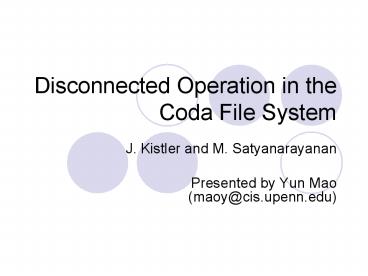Disconnected Operation in the Coda File System - PowerPoint PPT Presentation
1 / 28
Title:
Disconnected Operation in the Coda File System
Description:
We are back to 1990s. Network is slow and not stable ... IBM Thinkpad 10 yrs anniversary. Do we still need disconnection? How many people are using coda? ... – PowerPoint PPT presentation
Number of Views:83
Avg rating:3.0/5.0
Title: Disconnected Operation in the Coda File System
1
Disconnected Operation in the Coda File System
- J. Kistler and M. Satyanarayanan
- Presented by Yun Mao (maoy_at_cis.upenn.edu)
2
Background
- We are back to 1990s.
- Network is slow and not stable
- Terminal ? powerful client
- 33MHz CPU, 16MB RAM, 100MB hard drive
- Mobile Users appeared
- 1st IBM Thinkpad in 1992
- We can do sth at client without network
3
Motivation
4
Disconnected Operation
- Continue critical work when that repository is
inaccessible. - Key idea caching data.
- Performance
- Availability
- Server Replication
5
An Example
6
An Example
7
An Example
8
An Example
9
An Example
10
An Example
11
Design Rationale
- Scalability
- Callback cache coherence (inherit from AFS)
- Whole file caching
- Fat clients. (security, integrity)
- Avoid system-wide rapid change
- Portable workstations
- Users assistance in cache management
12
Design Rationale -Replication
- Server replication (why?)
- Persistent, Secure physically
- - Expensive
- Client replication
- - Low quality relatively
- Cheap
13
Design Rationale Replica Control
- Pessimistic
- Disable all partitioned writes
- - Require a client to acquire control of a cached
object prior to disconnection - Optimistic
- Assuming no others touching the file
- sophisticated conflict detection
- fact low write-sharing in Unix
- high availability access anything in range
14
Implementation - architecture
15
Venus - states
16
Hoarding
- Hoard useful data for disconnection
- Balance the needs of connected and disconnected
operation. - Cache size is restricted
- Unpredictable disconnections
- Prioritized algorithm cache manage
- hoard walking reevaluate objects
17
Prioritized algorithm
- User defined hoard priority p how interest it
is? - Recent Usage q
- Object priority f(p,q)
- Kick out the one with lowest priority
- Fully tunable
- Everything can be customized
- - Not tunable (?)
- No idea how to customize
18
Hoard Walking
- Equilibrium uncached obj lt cached obj
- Why it may be broken? Cache size is limited.
- Walking restore equilibrium
- Reloading HDB (changed by others)
- Reevaluate priorities in HDB and cache
- Enhanced callback
- Increase scalability, and availability
- Decrease consistency
19
Emulation
- Act like a server
- Record modified objects
- Replay update activity Preparation
- Log based per volume
- Persistence
- Meta-data ? RVM
- Exhaustion
- Compress?
20
Reintegration
- Replay algorithm
- Execute in parallel to all AVSG
- Transaction based
- Succeed?
- Yes. Free logs, reset priority
- No. Save logs to a tar. Ask for help
21
Conflict Handling
- Only care write/write confliction
- File vs Directory
- File Halt entire reintegration process
- Dir investigate more
- Manual repair
22
Coda Evaluation
- Hardware
- 386 laptop, IBM Decstation 3100s
- 350MB disk
- How ?
- How long does reintegration take?
- How large a local disk does one need?
- How likely are conflicts?
23
Answers
- Duration of Reintegration
- A few hours disconnection -gt1 min
- Cache size
- 100MB at client is enough for a typical workday
- Conflicts
- No Conflict at all! Why?
- Over 99 modification by the same person
- Two users modify the same obj within a day
lt0.75
24
Conclusion
- Disconnected operation is a simple idea
- Hard to implement in each stage
- Why?
- An extended version of write-back cache?
- A critical data pre-fetched write-back cache
- Feasible, efficient and usable.
25
Remember this slide?
- We are back to 1990s.
- Network is slow and not stable
- Terminal ? powerful client
- 33MHz CPU, 16MB RAM, 100MB hard drive
- Mobile Users appear
- 1st IBM Thinkpad in 1992
26
Whats now?
- We are in 2000s now.
- Network is fast and reliable in LAN
- powerful client ? very powerful client
- 2.4GHz CPU, 1GB RAM, 120GB hard drive
- Mobile Users everywhere
- IBM Thinkpad 10 yrs anniversary
- Do we still need disconnection?
- How many people are using coda?
- a script of rsync, Unison (Penn)
27
Do we still need disconnection?
- WAN and wireless is not very reliable, and is
slow - PDA is not very powerful
- 200MHz strongARM, 128M CF Card
- Electric power constrained
- LBFS (MIT) on WAN, Coda and Odyssey (CMU) for
mobile users - Adaptability is also cared.
28
What is the future?
- We are in 2010s now
- High bandwidth, reliable wireless everywhere
- Even PDA is powerful
- 2GHz, 1G RAM/Flash
- Unlimited kinetic or solar energy (?)
- What will be the research topic in FS?
- P2P?































